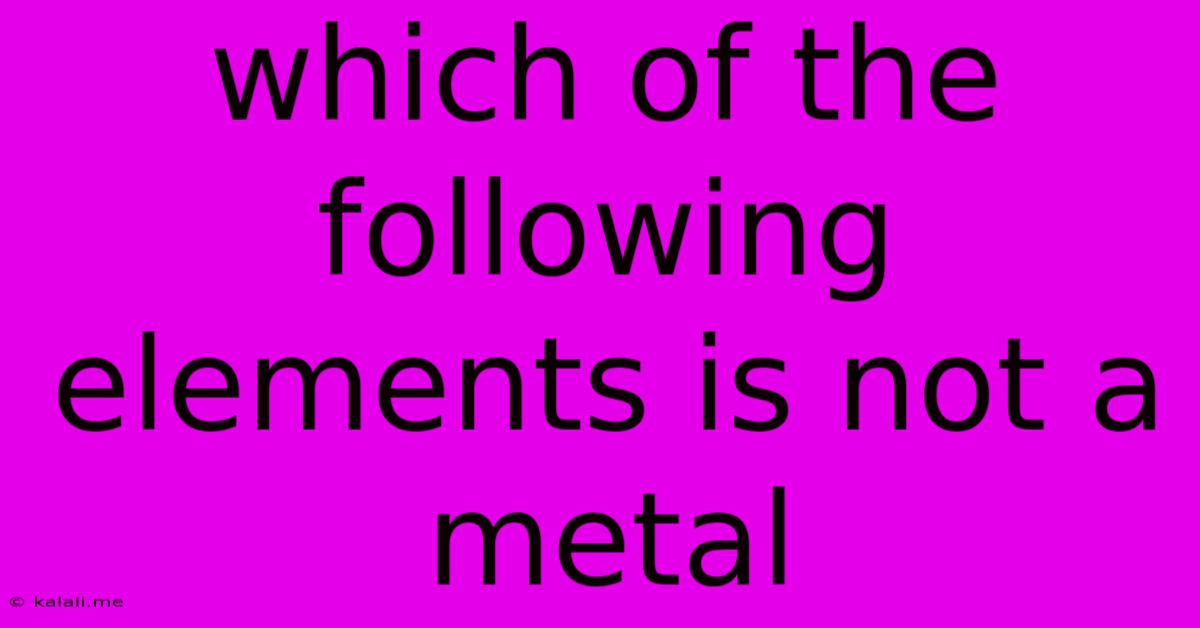Which Of The Following Elements Is Not A Metal
Kalali
Jun 13, 2025 · 3 min read

Table of Contents
Which of the Following Elements is Not a Metal? Identifying Metalloids and Nonmetals
This article explores the fascinating world of elements and helps you differentiate between metals, metalloids, and nonmetals. We'll delve into the characteristics that define each group and ultimately answer the question: which of the following elements is not a metal? Understanding this classification is crucial for various scientific fields, from chemistry and physics to materials science and engineering.
What are Metals?
Metals are typically characterized by their luster (shiny appearance), malleability (ability to be hammered into sheets), ductility (ability to be drawn into wires), and excellent conductivity of heat and electricity. They tend to lose electrons easily, forming positive ions. Examples of common metals include iron (Fe), copper (Cu), gold (Au), and aluminum (Al). These elements are generally found on the left side of the periodic table.
What are Nonmetals?
Nonmetals, on the other hand, lack the characteristic properties of metals. They are generally poor conductors of heat and electricity, are brittle (rather than malleable or ductile), and often have a dull appearance. They tend to gain electrons, forming negative ions. Examples include oxygen (O), carbon (C), sulfur (S), and chlorine (Cl). These are predominantly located on the right side of the periodic table.
Understanding Metalloids (Semimetals): The Bridge Between Metals and Nonmetals
Metalloids, also known as semimetals, are elements that exhibit properties of both metals and nonmetals. Their conductivity, for instance, is intermediate, and they often possess a semi-conductive nature—a property crucial in the electronics industry. Silicon (Si) and germanium (Ge) are prime examples, widely used in semiconductors. These elements form a zig-zag line separating metals and nonmetals on the periodic table.
Identifying the Non-Metal in a List
To determine which element from a given list is not a metal, you need to consider the properties discussed above. Let's look at a hypothetical example:
Example List: Sodium (Na), Chlorine (Cl), Aluminum (Al), Silicon (Si)
- Sodium (Na): A highly reactive alkali metal.
- Chlorine (Cl): A highly reactive nonmetal gas.
- Aluminum (Al): A lightweight, ductile metal.
- Silicon (Si): A metalloid, exhibiting properties of both metals and nonmetals.
In this example, Chlorine (Cl) is clearly the element that is not a metal. It's a nonmetal with properties distinctly different from metals.
Key Considerations:
- The Periodic Table: The periodic table is your best friend when identifying metals, nonmetals, and metalloids. The arrangement of elements reflects their properties.
- Physical Properties: Look for characteristic properties like luster, conductivity, malleability, and ductility. The absence of these properties often indicates a nonmetal or metalloid.
- Chemical Properties: Consider the element's reactivity and tendency to gain or lose electrons.
By understanding the defining characteristics of metals, nonmetals, and metalloids, you can confidently identify which element in a list is not a metal. Remember to consult the periodic table and consider both physical and chemical properties for accurate identification. This knowledge is foundational in various scientific disciplines and helps appreciate the diverse nature of the elements that make up our world.
Latest Posts
Latest Posts
-
A Price Ceiling Set Below The Equilibrium Price Will
Jun 14, 2025
-
Two Elements That Are Liquid At Room Temperature
Jun 14, 2025
-
The Maximum Bcd Value Of A Single Decimal Is
Jun 14, 2025
-
All Of The Following Nucleotide Bases Are Pyrimidines Except
Jun 14, 2025
-
Which Of The Following Is Not A Measure Of Retention
Jun 14, 2025
Related Post
Thank you for visiting our website which covers about Which Of The Following Elements Is Not A Metal . We hope the information provided has been useful to you. Feel free to contact us if you have any questions or need further assistance. See you next time and don't miss to bookmark.